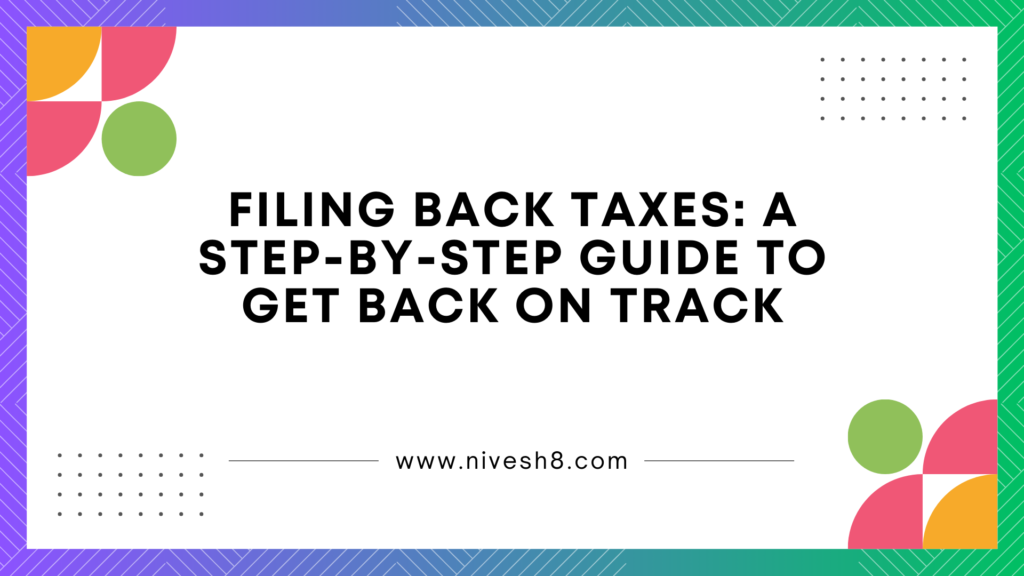Filing taxes may be somewhat challenging, and occasionally events occur and deadlines are missed. If you have unfiled taxes for one or more years, you must file back taxes to avoid penalties and interest. Ignoring the issue might cause liens, pay garnishments, or other dire consequences. This page will walk you through the process of accurately filing back taxes.
Back Taxes: Describe Them
Back taxes are those taxes not paid or filed by the due date. You have to file back taxes by forwarding the IRS your tax returns from past years if you want your overdue tax load paid off. Early action will help to lower the interest rates and penalty charges.
Why Should One File Back Taxes?
Ignoring past due taxes can have major financial and legal consequences. The following justifies giving filing back taxes first priority:
- Unpaid taxes run an interest and late payment penalty risk from the IRS.
- Should you be qualified for a refund, you have three years to request one.
- The IRS could seek legal actions, including wage garnishment or property liens.
- Improve Your Credit Score: Should you have unresolved tax problems, your credit could suffer.
- Eligible for Financial Aid: Current loan or federal benefit returns could be needed.
How to Start Refunding Taxes?
First Step: Gather Your Records
Filing back taxes starts with gathering the necessary documentation. You will need:
- W-2 Documents: For funds obtained via employment.
- 1099 Forms: For income generated by freelancers or contractors.
- Bank Statements: Help to verify outlays and revenues.
- Among the Deductible Receipts: Medical bills, mortgage interest, and charitable contributions.
- Previous Tax Returns: For reference, if at hand.
Should any documentation disappear, you can request them from your company or the IRS’s Get Transcript tool.
Second Step: Obtain the Relevant Tax Paperwork
Every tax year has specific forms and guidelines. Visit the IRS official website to download the necessary forms for every year you are submitting. Please ensure:
- Use the correct documentation for each year.
- Add any essential additional schedules or documentation.
- Print or electronically complete the forms.
Third Step: Finish Your Tax Returns
When filing back taxes, take your time and ensure that each return is accurately completed. Consider these:
- Declare All Earnings: Missing income data could cause delays or denials.
- Claim Eligible Credits and Deductions: Helps you to reduce your taxable income.
- Calculate Interest and Penalties: While the IRS will add these amounts, it’s a smart idea to have an estimate.
Step 4: Send the IRS Your Returns
Since filing back taxes for the bulk of prior years cannot be done electronically, you must mail the paper documentation to the IRS. Apply these steps:
- Review Your Information Once More: Make sure everything is accurate to avoid processing delays.
- Should Payment Be Due, Include It: If you owe taxes, put a cheque or money order in there.
- Certified Mail: Guarantees that your documents are received and provides evidence of submission.
What Happens Should You Be Unable to Pay?
Consider these decisions while filing back taxes if you have a significant debt you cannot pay off in whole:
- Installment Agreements: Let you pay over time.
- Offer in Compromise: Pay off some of your debt to show a compromise.
- Not Collectible Right Now Status: Collection will be temporarily discontinued should you be having financial problems.
How Should One Track the Situation Regarding Your Back Tax Submission?
Given the IRS handles back taxes by hand, your account may not be updated for weeks or even months. You can track your advancement using:
- Making an IRS Call: Call the toll-free number to inquire about your situation.
- Online Check: Use the IRS “Where’s My Refund?” page should you expect a return.
- Speaking with a Tax Expert: They can represent you before the IRS.
Guideline for Good Back Tax Filing
- File as Soon as Possible: Penalties and interest rise with the delay you cause.
- Consult a Tax Professional: They can assure accuracy and negotiate with the IRS.
- Organize: Save copies of every IRS letter and filed return.
- Review Penalty Abatement: You may be qualified to have fines waived if you had a legitimate reason for submitting late.
Typical Mistakes to Steer Clear of When Turning in Back Tax Returns
- Absence of Filing: Ignoring the matter will only make things worse.
- Use the Correct Forms: Ensure you are using the forms suitable for every tax year.
- Ignorance of Income Sources: Could lead to IRS audits.
- Unsigned Returns: Will be returned.
The IRS Has How Much Time to Reimburse?
Usually, the IRS has three years to examine your return. Although there is no statute of limitations, should you not file at all, the IRS may pursue you at any moment. Filing back taxes as soon as it is practical is thus rather important.
In Sum
Filing back taxes is essential to get your finances back on track, despite the fact that it may feel burdensome. By carefully turning in your papers and choosing the correct forms, you can lower fines and interest. If you’re confused or feeling overburdened, see a tax specialist to assist you in navigating the process. If you start today, you will save money and avoid stress later on.



